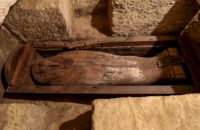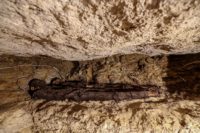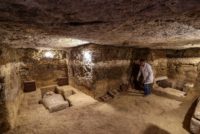 Egypt’s Ministry of Tourism and Antiquities made the first announcement of an archaeological discovery of the new year on Thursday. The find is a group tomb for the high priests of Thoth, their families and top officials of the 15th nome unearthed at the Al-Ghoreifa site in Egypt’s Minya governate. Archaeologists found 16 tombs containing 20 sarcophagi dating to the Pharaonic Late Period, 664-399 B.C., in use for three dynasties. Five of them are anthropoid limestone engraved with hieroglyphics and five are wooden coffins in good condition decorated with the names of their owners.
Egypt’s Ministry of Tourism and Antiquities made the first announcement of an archaeological discovery of the new year on Thursday. The find is a group tomb for the high priests of Thoth, their families and top officials of the 15th nome unearthed at the Al-Ghoreifa site in Egypt’s Minya governate. Archaeologists found 16 tombs containing 20 sarcophagi dating to the Pharaonic Late Period, 664-399 B.C., in use for three dynasties. Five of them are anthropoid limestone engraved with hieroglyphics and five are wooden coffins in good condition decorated with the names of their owners.
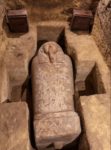 An inscription on one of the stone sarcophagi is dedicated to the Ibis-headed god of writing and wisdom Thoth (Djehuti in Egyptian) who was often represented as a baboon as well. Thousands of mummified ibis and baboons have been found at this site in previous excavations, so the tomb was probably built to house the priests of Thoth.
An inscription on one of the stone sarcophagi is dedicated to the Ibis-headed god of writing and wisdom Thoth (Djehuti in Egyptian) who was often represented as a baboon as well. Thousands of mummified ibis and baboons have been found at this site in previous excavations, so the tomb was probably built to house the priests of Thoth.
Of the five stone sarcophagi, two are still sealed and in excellent condition. One belonged to the son of Psamtik, head of the royal treasury and priest of Osiris and Nut. The second is dedicated to Horus and is decorated with the 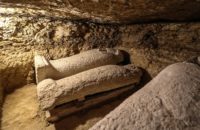 goddess Nut spreading her wings. The inscription identifies its owner as Epy. One of the coffins, belonging to Djed, is particularly significant for the importance of the titles inscribed on the lid: royal treasurer, bearer of the seals of Lower Egypt and sole companion of the king.
goddess Nut spreading her wings. The inscription identifies its owner as Epy. One of the coffins, belonging to Djed, is particularly significant for the importance of the titles inscribed on the lid: royal treasurer, bearer of the seals of Lower Egypt and sole companion of the king.
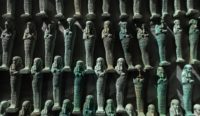 The mission also discovered sets of limestone and alabaster canopic jars made to house the organs of the mummified, 10,000 ushabti figurines made of faience, most of which are engraved with the names of the deceased, and 700 amulets. Many of the amulets are scarabs, but there are a variety of other subjects including one rare winged cobra made of pure gold. A great variety of pottery vessels used for funerary and religious purposes were found. One unexpected discovery were tools left behind by the workers who made the tomb. Archaeologists found stone-cutting tools, wooden hammers and baskets made of palm fronds.
The mission also discovered sets of limestone and alabaster canopic jars made to house the organs of the mummified, 10,000 ushabti figurines made of faience, most of which are engraved with the names of the deceased, and 700 amulets. Many of the amulets are scarabs, but there are a variety of other subjects including one rare winged cobra made of pure gold. A great variety of pottery vessels used for funerary and religious purposes were found. One unexpected discovery were tools left behind by the workers who made the tomb. Archaeologists found stone-cutting tools, wooden hammers and baskets made of palm fronds.
